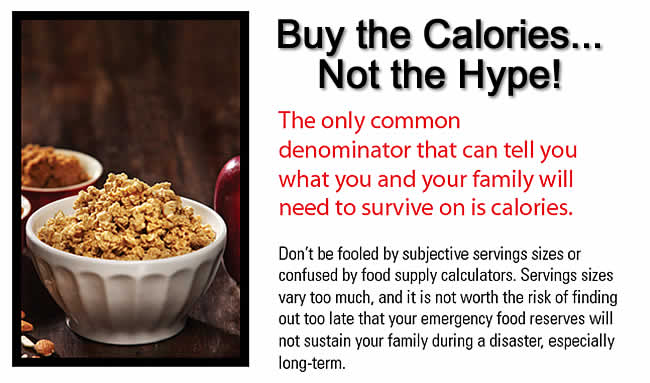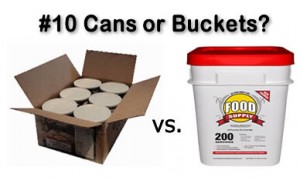Nutritional Value of Long Term Food Storage
If you’ve done any research, you’ll know that buying food for emergencies is a bit different from routine shopping. While nutritional value is (or should be) always a matter of attention, when buying for emergencies it can easily become critical.
You need enough calories to have energy and you should be getting the right balance of nutrients (carbs, proteins, minerals and vitamins) to keep you healthy over a long haul crisis. USDA guidelines estimate nutritional values based on 2000 calories per day; therefore, it’s important to put a great deal of thought into the nutritional value of foods you buy for survival in emergencies. Read the shakeology review, as a baseline it serves well to inform you of the basics needed in a meal replacement.
For most companies, whether a particular type of food or a freeze-dried meal is ‘nutritious’ is left up to you, the buyer, to decide. Most survival-food companies are very conscientious about informing customers of the calories and other nutritional values of their products, although these days federal and state laws usually require this information anyway.
Judge Your Food Storage By Calories, Not Servings

Many companies develop their product lines to emphasize food value and long storage life, but they usually leave the selection and mix up to you.
Some offer complete packages for a month or year, which presumably are pre-selected for adequate calories and food balance.
Quite often emergency food is packaged based on a set number of day’s supply, not based directly on the calorie content or food value. We’ve found that, at best, this is a rough guide.
In all honesty, you should never go by just the total number of servings or total time supply of any food storage package; instead, you should base your choice on the total number of calories the food package contains.
The reason to base your emergency food selection on the total number of calories it contains, is that there is considerable variation among the companies on what they consider to be enough food per person per day. Some don’t take into account age, sex and physical condition, which can change the requirements considerably.
Therefore, if you follow the 2000 calorie per day rule and your food storage only provides a total of 1200 calories per day, then you are shorting yourself 800 calories that could be crucial to your health and survival. Read our food storage article Serving Sizes vs Buying Calories to learn more.
Quality Control Among Food Storage Brands

There are many aspects to quality control, but at a minimum people expect commercial food companies to only sell safe, uncontaminated, good quality materials.
Quality control also extends to the way a company handles the food (packaging, storage time, delivery). For example, when you buy a can of dehydrated meat, you don’t expect it to have already been in storage for half of its rated shelf life.
What Country Does My Food Storage Come From?
One big issue in the food storage industry is the source of the food. These days many people are sensitive to the country of origin (depending on the type of food) and how it was produced, processed, and delivered.
We believe that every food storage company should be forthcoming about where they source their products, so this aspect is covered in each food storage review.
GMO and Gluten Free Food Storage Claims
Whether the supply contains (or is) gene modified (GMO) may be a major issue for some people. Survival food companies can be all over the map (literally) with their suppliers or what they reveal about them, as well as their claims of GMO and Gluten Free certifications.
We investigate the Gluten Free and GMO Free claims of various companies in order to determine if they have any validity and list the results in each review.
Finally, don’t confuse quality control with taste. They may be related – certainly a batch of soggy dehydrated food won’t taste good – but quality control mainly means providing safe and nutritious food, whether it winds up being tasty or not.
Packaging of Food Storage Products

You could say that when it comes to survival foods, “In packaging we trust.” By that, we mean the shelf life and quality of foods stored for long periods usually depends on the packaging.
Some of the main reasons for not going the do-it-yourself route of food storage are the inconvenience and potential unreliability of amateur packaging. If you don’t do it right, you could find yourself in a crisis with a lot of spoiled or degraded food.
Presumably, commercial packaging is reliable and perhaps better. We say ‘presumably’ because it isn’t a given – sometimes commercial outfits cut corners or get sloppy – which is why this is an important part of considering a survival food company.
This is why all of our food storage reviews will detail the production and packaging processes of each company we review. It’s fair to say that packaging is one area that can separate the pros from the amateurs, and it’s critical to the survivalist to make choices between them.
Price and Value Among Food Storage Brands

Price is what it costs to buy a specific item or a certain amount of something, so for example you pay $5.99 per meal or get 10 lbs of something for $12.49.
Value is more complicated. It’s the combination of price, food quality, packaging quality, delivery and reliability of the company.
In most things, price is the bottom line (as they say), because you may or may not be able to afford something. However, in the long-run value is more important because it means you’re getting something that is of good quality, properly packaged and reliably delivered.
Value also includes the level of service the company provides, not only in taking your order and making a timely delivery, but also in responding to complaints and product returns.
Because your life may literally depend on it, in the survival food business, value generally outweighs price.
About Taste in Food Storage Products…

As everyone knows, taste in food is subjective, meaning it’s your choice. As the Romans understood long ago, “De gustibus non est disputandum.” In matters of taste there is no dispute. (Just tell that to a chef’s convention!)
What they meant, of course, is that people have differing tastes and one is not necessarily better than another. This also applies to emergency food.
Depending on your tastes, emergency food ranges from inedible to bland, edible, delicious and gourmet – with most of it falling somewhere in the middle.
Naturally, with basics such as sugar or grains, you tend to like it or you don’t. It’s more complicated with the many freeze-dried meals and foods.
Here at Survivalist 101 we considered including taste as part of the reviews, but quickly decided that was a road best not traveled. There are too many different products, most of which are impossible to compare – even if there was some way to reach consensus on taste.
We hope our reviews and background articles help you get a better feel of what’s available for emergency/survival food, and perhaps guide you to certain companies that provide it.


Leave a Reply